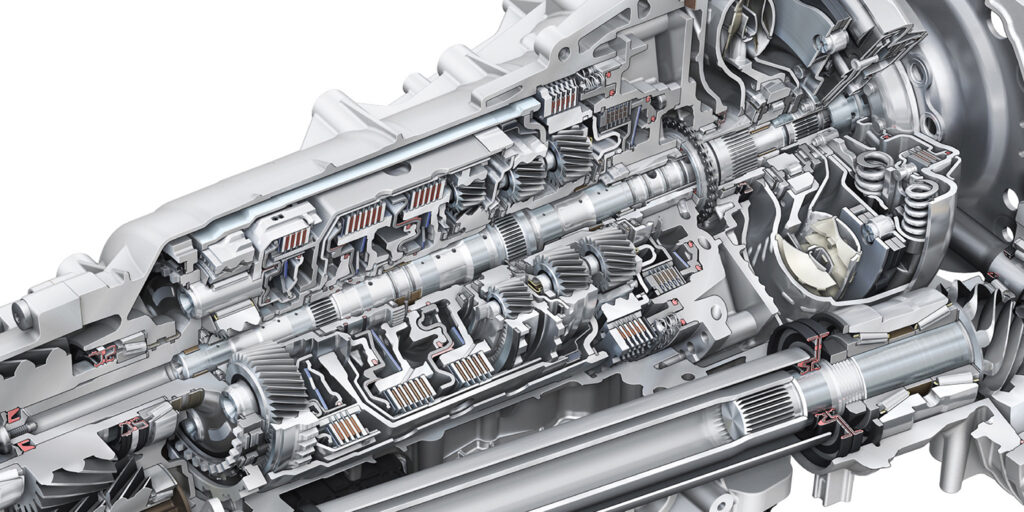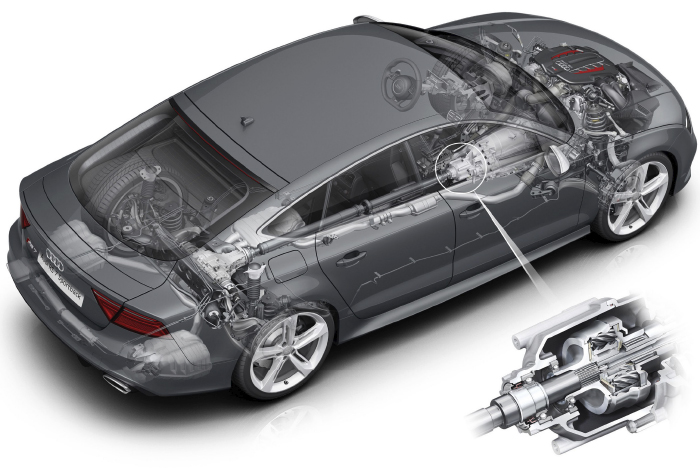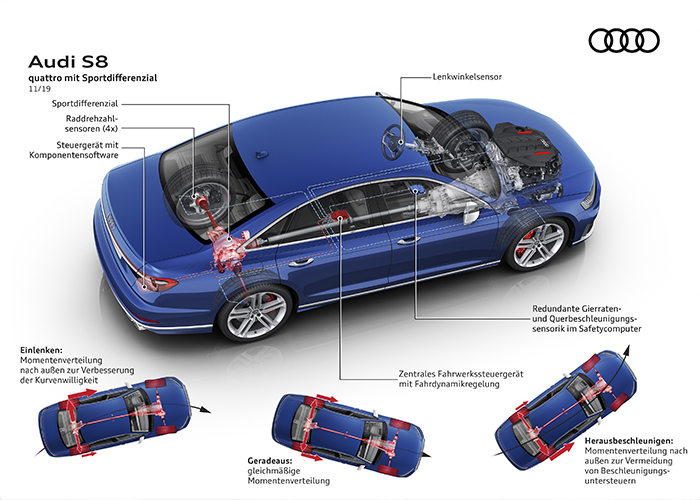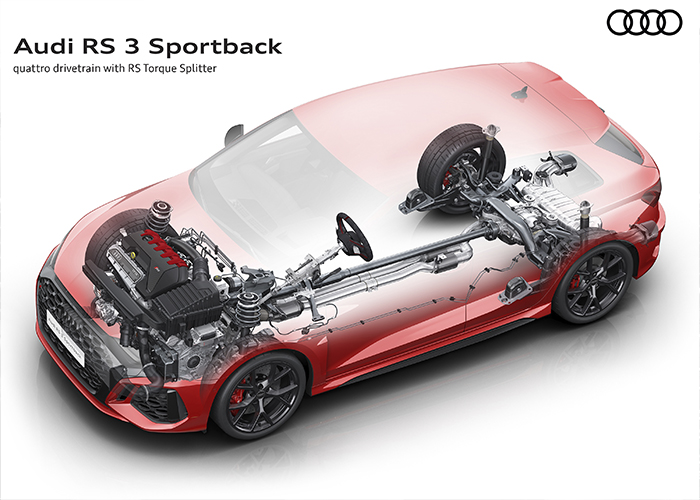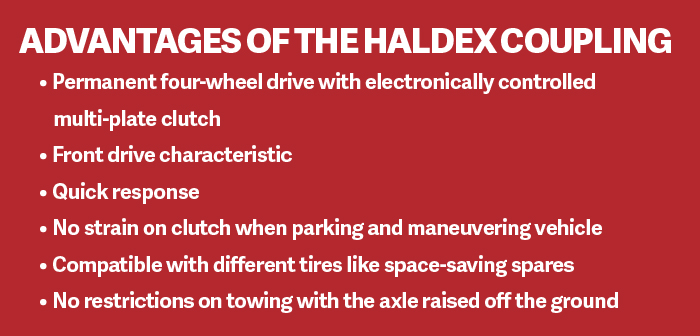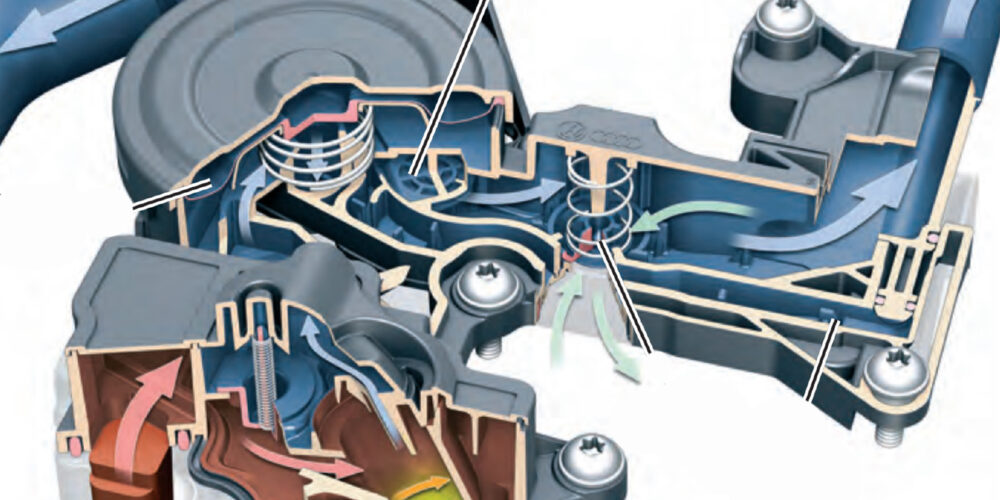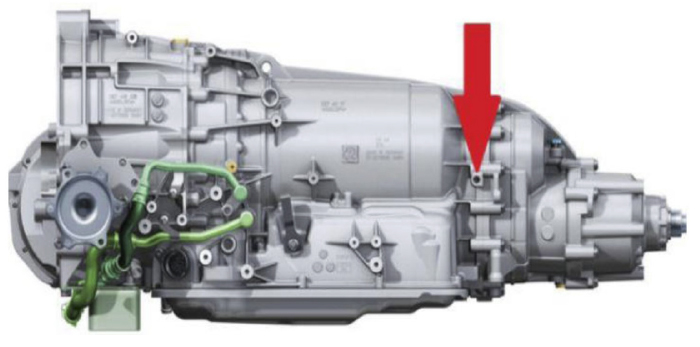The first systems had locking differentials the driver could control. In 1986, the Quattro system received a Torsen center differential. In 1999, some models received a viscous coupling. Since the mid-2000s, many models have a crown gear center differential. At the front and rear differentials, electrically actuated clutches work with the center differential and stability control system to send power to the wheel that needs it.
As the Quattro system has evolved, so have the controls for the front, rear and center differential systems. Early systems used engine vacuum to lock the differentials. Later models used hydraulic fluid and solenoids to control the differentials. Now, the differentials are controlled with clutches to vector the torque.
The all-wheel-drive control module continuously calculates the best torque distribution between the front and rear axles based on extensive data. When the requirements change, the electric axial piston pump builds up as much as 650 psi of hydraulic pressure within just a few milliseconds. It presses the friction plates together, which enables variable transmission of the drive torque from the front axle to the rear. The oil pump is activated electrically when the engine speed exceeds 400 rpm. The electrical oil pressure pump extracts hydraulic fluid from the depressurised chamber of the clutch housing through a strainer and pumps the oil through a filter via the suction valves on the lifting piston.
The water-cooled multi-plate clutch in the center differential distributes the necessary torque to the front wheels in any driving situation, is integrated within this. There is no fixed basic distribution; in extreme cases, up to 100% can be transmitted to the front or rear axle.
The layout of the Quattro transmission has changed over the years and for different models. Most late-model Audi cars with a longitudinal-mounted engine have moved the center differential to the rear of the transmission. The front differential or driveshaft on some is no longer inside the transmission.
Since Audi has been sharing platforms with VWs that have a transversely mounted engine like the TT and A3, the Haldex system has made its way to Audi. The Haldex coupling is mounted on the rear axle differential and is driven by the drive shaft. Engine torque is transmitted to the driveshaft through the gearbox, the front axle differential, and the front axle drive.
The driveshaft is connected to the input shaft of the Haldex coupling. In the Haldex coupling, the input shaft is separated from the output shaft to the rear axle differential. Torque can only be transmitted to the rear axle differential when the Haldex coupling clutch plates are engaged.
The development of the Haldex coupling was a giant step forward in modern four-wheel-drive technology. The Haldex coupling is controllable. A processor also makes allowance for additional information during the control process. Slip is no longer the only decisive factor in the distribution of drive forces; the car’s dynamic state is also a factor. The processor accesses the ABS wheel speed sensors and the engine control unit (accelerator pedal signal) via the CAN bus.
This data provides the processor with all the information it needs on road speed, cornering, overrun or traction mode, and can respond optimally to any driving situation.
Torque input also ensures a neutral road behavior. The sport differential is active not only under load, but also on overrun. Its torque-distributing action enhances car agility when the clutch is disengaged. Depending on steering angle, lateral acceleration, yaw angle, road speed, and other signals, the control module calculates the most suitable distribution of torque to the rear wheels for every driving situation.
When the steering wheel is turned, for example, or when the car is accelerated in a corner, power is redirected in a controlled manner to the outer rear wheel. This has the effect of “forcing” the car into the corner so that the angle of the front wheels is followed accurately. The difference in tractive force between the left and right wheels also exerts a steering effect, so that the usual corrections by the driver at the steering wheel are no longer needed. Understeer, the tendency for the car to run wide at the front when cornering, is virtually eliminated.
When approaching the car’s handling limits, the sport differential acts like ESP, but with the principle reversed. Corrective movements are not initiated solely by altering the engine settings or applying the brakes, but also by controlled redistribution of tractive force through the sport differential. The car’s forward progress becomes distinctly smoother and free-flowing because its actual road dynamics and those sensed subjectively by the driver are enhanced since ESP comes into action much less frequently. Since its reaction time is extremely short — less than 100 milliseconds — the sport differential takes effect even more rapidly than ESP. Furthermore, ESP can react only to a discrepancy between the car’s steering angle and its actual body rotation, whereas the sport differential influences the car’s dynamic behavior before any such discrepancies occur. During sport differential action, ESP is not active. Active torque distribution is based on an entirely new design principle for the rear axle differential. The unit can also divert torque to the outer wheel on the axle, which then rotates faster than the inner wheel when cornering. The rear axle differential has speed modulation units with multi-plate clutches mounted at the left and right sides. The clutches are activated by electro-hydraulic actuators based on input from sensors and other control modules.
Maintenance
With most late-model Audi differentials, there might not be a replacement interval for the fluid inside the case. In the service schedule, it is recommended the fluid is inspected every other oil change, or every 20,000 miles. It can be impossible to observe the condition of the fluid. But if the axle or shaft seals are leaking, the fluid needs to be replaced and the seal fixed. For Haldex-equipped vehicles, the clutch fluid needs to be replaced every 35,000 miles.
Audi Quattro vehicles can come with manual, automatic or dual-clutch (DSG) transmissions. The fluid maintenance intervals for transmissions can vary. The DSG requires fluid replacement every 35,000 miles.

